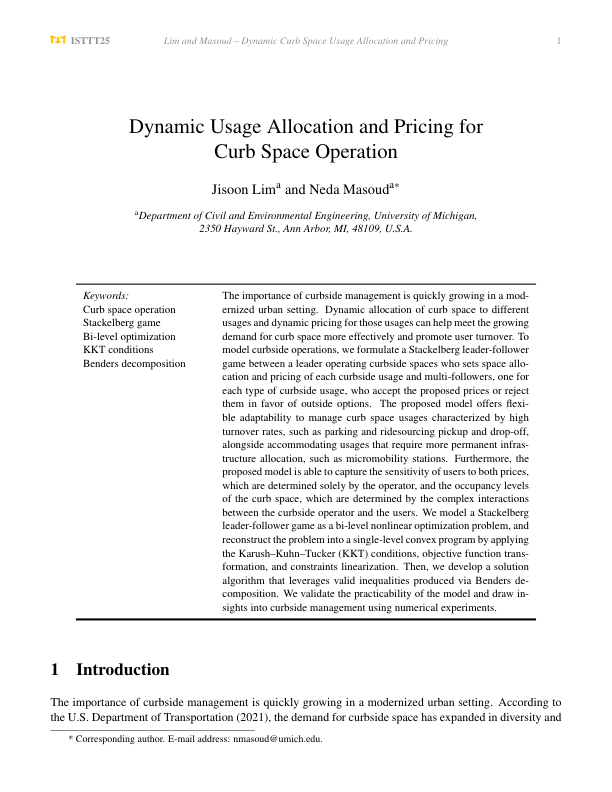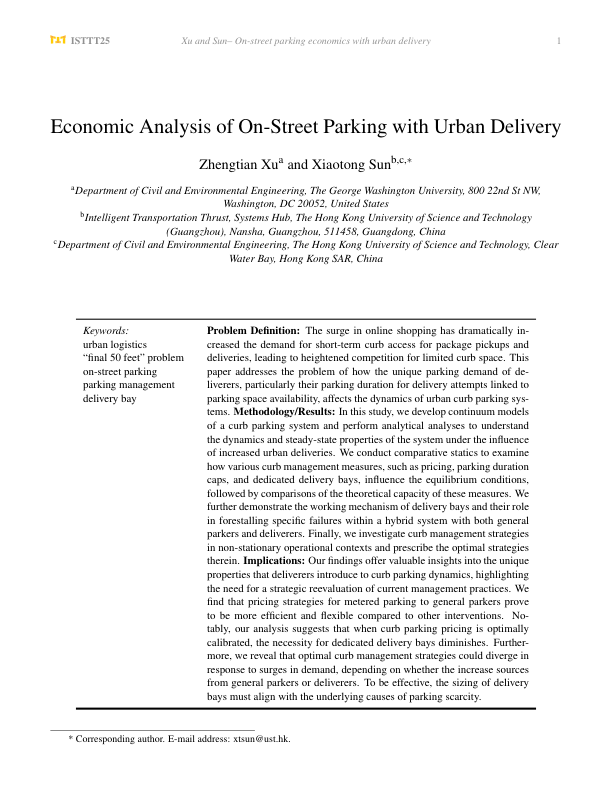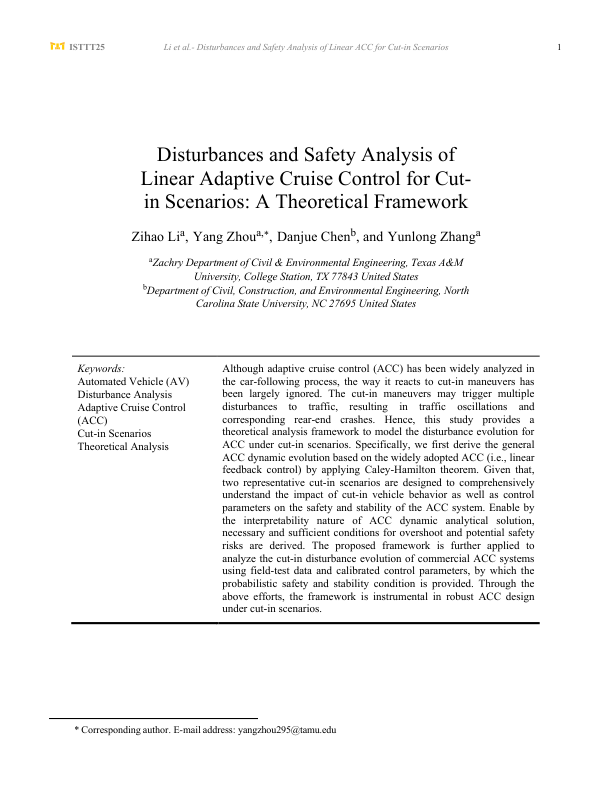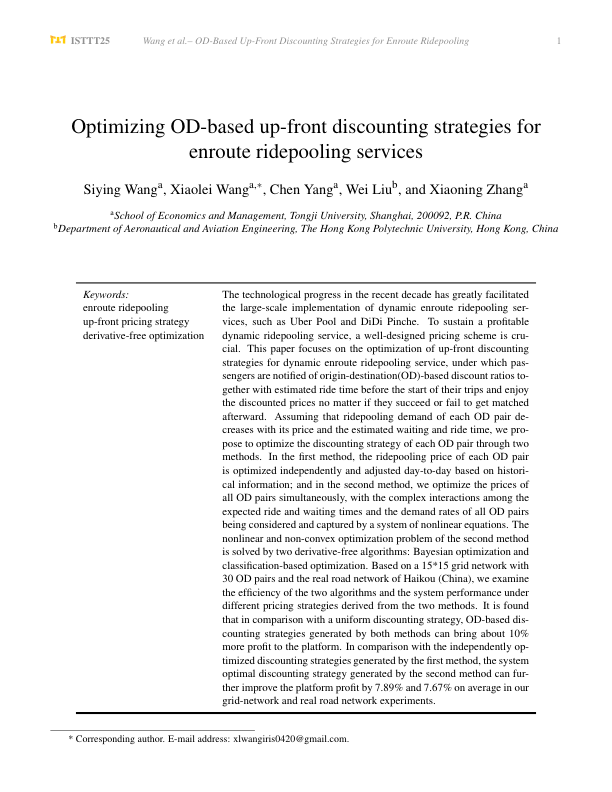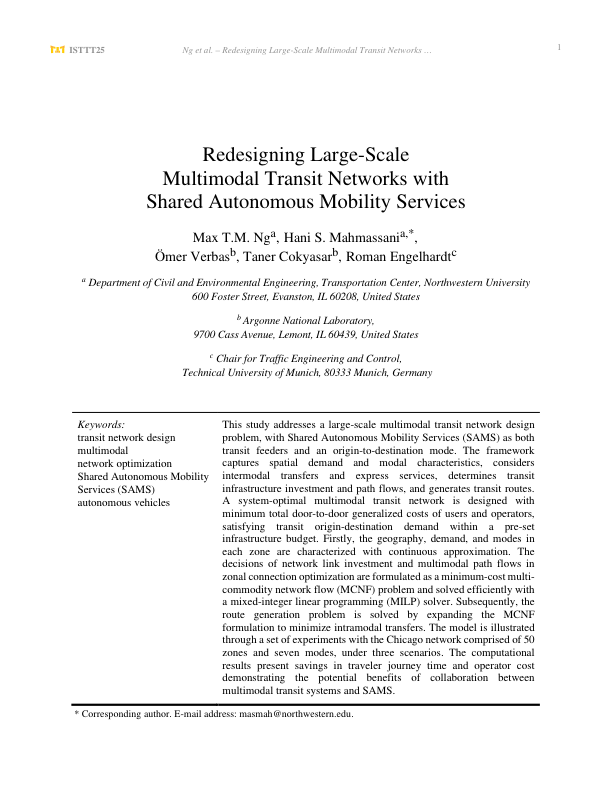Workshop 1: New Entrants in the Airspace: Handling Uncertainty and User Privacy
Title: New Entrants in the Airspace: Handling Uncertainty and User Privacy
Presenter: Max Li
Workshop 1: Enhancing Mobility: The Role of Peer-to-Peer Systems in Modern Transportation
Title: Enhancing Mobility: The Role of Peer-to-Peer Systems in Modern Transportation
Presenter: Neda Masoud
Workshop 1: Challenges and Policy Trends for Future Urban Public Transport Service
Title: Challenges and Policy Trends for Future Urban Public Transport Service
Presenter: Avishai Ceder
Workshop 2: Is Fare Free Transit Just? Quantifying the Impact of Moral Principles on Transit Design and Finance
Title: Is Fare Free Transit Just? Quantifying the Impact of Moral Principles on Transit Design and Finance
Presenter: Yu (Marco) Nie
Workshop 2: Balancing Efficiency and Fairness in Traffic Management and Control
Title: Balancing Efficiency and Fairness in Traffic Management and Control
Presenter: Lina Kattan
Workshop 2: The Equity-Efficiency Trade-off in Transportation: Analyzing the Optimal Joint Pricing and Resource Allocation Strategies under Equity Constraints
Title: The Equity-Efficiency Trade-off in Transportation: Analyzing the Optimal Joint Pricing and Resource Allocation Strategies under Equity Constraints
Presenter: Sisi Jian
Tribute to Richard Allsop, 2 May 1940 – 19 January 2024
Title: Tribute to Richard Allsop, 2 May 1940 - 19 January 2024
Authors: Benjamin Heydecker
Podium Session 1: Alleviating Bus Bunching via Modular Vehicles
Title: Alleviating Bus Bunching via Modular Vehicles
Authors: Yuhao Liu, Zhibin Chen, Xiaolei Wang
Abstract: The notorious phenomenon of bus bunching prevailing in uncontrolled bus systems produces irregular headways and downgrades the level of service by increasing passengers’ expected waiting time. Modular autonomous vehicles (MAVs), due to their ability to split and merge enroute, have the potential to help both late and early buses recover from schedu...
Keywords: Bus bunching; Modular vehicle; Dynamic system; Deep reinforcement learning
Podium Session 1: A Seamless Bus Network without External Transfers Using Autonomous Modular Vehicles
Title: A Seamless Bus Network without External Transfers Using Autonomous Modular Vehicles
Authors: Zaid Saeed Khan, Mónica Menéndez
Abstract: Recently, autonomous modular vehicles (AMVs) capable of enabling in-motion transfer (IMT), i.e. passengers moving between vehicles while the vehicles are traveling, have been developed. IMT allows new paradigms for public transport operations that can enhance the speed, flexibility, and reliability of the system. We leverage IMT technology to propo...
Keywords: Autonomous modular buses; In-motion transfer; Stop-less bus; Transfer-less bus service; Bus network design
Podium Session 1: An Autonomous Modular Public Transit Service
Title: An Autonomous Modular Public Transit Service
Authors: Xi Cheng, Yu (Marco) Nie, Jane Lin
Abstract: In this work, we present a proof-of-concept investigation of Autonomous Modular Public Transit (AMPT) at a network scale and compare it with the traditional fixed-route, fixed-vehicle size transit service in terms of total cost, which consists of both agency’s capital and operational cost (including energy cost) and passenger time cost. We formulat...
Keywords: Autonomous Modular Vehicle Technology (AMVT); Autonomous Modular Public Transit (AMPT); Gridded fixed-route transit network; Pod; Joining/disjoining of pods; Agency and passenger costs
Podium Session 2: Modeling Multi-Modal Curbside Usage in Dynamic Networks
Title: Modeling Multi-Modal Curbside Usage in Dynamic Networks
Authors: Jiachao Liu, Sean Qian
Abstract: The proliferation of emerging mobility technology has led to a significant increase in demand for ride-hailing services, on-demand deliveries, and micro-mobility services, transforming curb spaces into valuable public infrastructure for which multi-modal transportation competes. However, the increasing utilization of curbs by different traffic mode...
Keywords: Dynamic traffic assignment; Curbside management; Mesoscopic traffic simulation; Dynamic OD demand estimation; Computational graph
Podium Session 2: Dynamic Usage Allocation and Pricing for Curbside Space Operation
Title: Dynamic Usage Allocation and Pricing for Curbside Space Operation
Authors: Jisoon Lim, Neda Masoud
Abstract: The importance of curbside management is quickly growing in a modernized urban setting. Dynamic allocation of curb space to different usages and dynamic pricing for those usages can help meet the growing demand for curb space more effectively and promote user turnover. To model curbside operations, we formulate a Stackelberg leader-follower game be...
Keywords: Curb space operation; Stackelberg game; Bi-level optimization; KKT conditions; Benders decomposition
Podium Session 2: Economic Analysis of On-Street Parking with Urban Delivery
Title: Economic Analysis of On-Street Parking with Urban Delivery
Authors: Zhengtian Xu, Xiaotong Sun
Abstract: Problem Definition: The surge in online shopping has dramatically increased the demand for short-term curb access for package pickups and deliveries, leading to heightened competition for limited curb space. This paper addresses the problem of how the unique parking demand of deliverers, particularly their parking duration for delivery attempts lin...
Keywords: Urban logistics; “Final 50 feet” problem; On-street parking; Parking management; Delivery bay
Podium Session 3: Destroying Phantom Jams with Connectivity and Automation: Nonlinear Dynamics and Control of Mixed Traffic
Title: Destroying Phantom Jams with Connectivity and Automation: Nonlinear Dynamics and Control of Mixed Traffic
Authors: Tamas G. Molnar, Gábor Orosz
Abstract: Connected automated vehicles (CAVs) have the potential to improve the efficiency of vehicular traffic. In this paper, we discuss how CAVs can positively impact the dynamic behavior of mixed traffic systems on highways through the lens of nonlinear dynamics theory. First, we show that human-driven traffic exhibits a bistability phenomenon, in which ...
Keywords: Connected automated vehicle; Mixed traffic; Nonlinear dynamics; Time delay
Podium Session 3: Disturbances and Safety Analysis of Linear Adaptive Cruise Control for Cut-in Scenarios: A Theoretical Framework
Title: Disturbances and Safety Analysis of Linear Adaptive Cruise Control for Cut-in Scenarios: A Theoretical Framework
Authors: Zihao Li, Yang Zhou, Danjue Chen, Yunlong Zhang
Abstract: Although adaptive cruise control (ACC) has been widely analyzed in the car-following process, the way it reacts to cut-in maneuvers has been largely ignored. The cut-in maneuvers may trigger multiple disturbances to traffic, resulting in traffic oscillations and corresponding rear-end crashes. Hence, this study provides a theoretical analysis frame...
Keywords: Automated Vehicle (AV); Disturbance analysis; Adaptive Cruise Control (ACC); Cut-in scenarios
Podium Session 3: On Dynamic Fundamental Diagrams: Implications for Automated Vehicles
Title: On Dynamic Fundamental Diagrams: Implications for Automated Vehicles
Authors: Jiwan Jiang, Yang Zhou, Xin Wang, Soyoung (Sue) Ahn
Abstract: The traffic fundamental diagram (FD) describes the relationships among fundamental traffic variables of flow, density, and speed. FD represents fundamental properties of traffic streams, giving insights into traffic performance. This paper presents a theoretical investigation of dynamic FD properties, derived directly from vehicle car-following (co...
Keywords: Automated vehicles; Fundamental diagram; Traffic hysteresis; Traffic oscillation
Lightning Talk 1: Combining Time Dependency and Behavioral Game: A Deep Markov Cognitive Hierarchy Model for Human-Like Discretionary Lane Changing Modeling
Title: Combining Time Dependency and Behavioral Game: A Deep Markov Cognitive Hierarchy Model for Human-Like Discretionary Lane Changing Modeling
Authors: Kehua Chen, Meixin Zhu, Lijun Sun, Hai Yang
Abstract: Human drivers take discretionary lane changes when the target lane is perceived to offer better traffic conditions. Improper discretionary lane changes, however, lead to traffic congestion or even crashes. Considering its significant impact on traffic flow efficiency and safety, accurate modeling and prediction of discretionary lane-changing (LC) b...
Keywords: Discretionary lane changing; Game theory; Hidden markov model; Cognitive hierarchy
Lightning Talk 1: Stability Analysis of a Departure Time Choice Problem with Atomic Vehicle Models
Title: Stability Analysis of a Departure Time Choice Problem with Atomic Vehicle Models
Authors: Koki Satsukawa, Kentaro Wada, Takamasa Iryo
Abstract: In this study, we analyse the global stability of the equilibrium in a departure time choice problem using a game-theoretic approach that deals with atomic users. We first formulate the departure time choice problem as a strategic game in which atomic users select departure times to minimise their trip cost; we call this game the ‘departure time ch...
Keywords: Convergence/stability; Departure time choice problem; Evolutionary dynamics; Epsilon-Nash equilibrium; Atomic users
Lightning Talk 1: Modeling Residual-Vehicle Effects in Undersaturation Conditions on Uncertainty Estimation of the Connected Vehicle Penetration Rate
Title: Modeling Residual-Vehicle Effects in Undersaturation Conditions on Uncertainty Estimation of the Connected Vehicle Penetration Rate
Authors: Shaocheng Jia, S.C. Wong, Wai Wong
Abstract: In the transition to full deployment of connected vehicles (CVs), the CV penetration rate plays a key role in bridging the gap between partial and complete traffic information. Several innovative methods have been proposed to estimate the CV penetration rate using only CV data. However, these methods, as point estimators, may lead to biased estimat...
Keywords: Connected vehicle penetration rate uncertainty; probabilistic penetration rate model; residual vehicle estimation; Markov-constrained queue; length model; signal control with uncertainty
Lightning Talk 1: A Topological Network Connectivity Design Problem Based on Spectral Analysis
Title: A Topological Network Connectivity Design Problem Based on Spectral Analysis
Authors: Shoichiro Nakayama, Shun-ichi Kobayashi, Hiromichi Yamaguchi
Abstract: How to improve network connectivity and which parts of the network are vulnerable are critical issues. We begin by defining an equal distribution problem, in which supplies are distributed equally to all nodes in the network. We then derive a topological network connectivity measure from the convergence speed, which is the second minimum eigenvalue...
Keywords: Connectivity; Fiedler vector; Semidefinite programing; Convexity
Lightning Talk 1: Optimizing OD-Based Up-Front Discounting Strategies for Enroute Ridepooling Services
Title: Optimizing OD-Based Up-Front Discounting Strategies for Enroute Ridepooling Services
Authors: Siying Wang, Xiaolei Wang, Chen Yang, Wei Liu, Xiaoning Zhang
Abstract: The technological progress in the recent decade has greatly facilitated the large-scale implementation of dynamic enroute ridepooling services, such as Uber Pool and DiDi Pinche. To sustain a profitable dynamic ridepooling service, a well-designed pricing scheme is crucial. This paper focuses on the optimization of up-front discounting strategies f...
Keywords: enroute ridepooling; up-front pricing strategy; derivative-free optimization
Lightning Talk 1: Two-Step Quadratic Programming for Physically Meaningful Smoothing of Longitudinal Vehicle Trajectories
Title: Two-Step Quadratic Programming for Physically Meaningful Smoothing of Longitudinal Vehicle Trajectories
Authors: Ximeng Fan, Wen-Long Jin, Penghang Yin
Abstract: Longitudinal vehicle trajectories suffer from errors and noise due to detection and extraction techniques, challenging their applications. Existing smoothing methods either lack physical meaning or cannot ensure solution existence and uniqueness. To address this, we propose a two-step quadratic programming method that aligns smoothed speeds and hig...
Keywords: Longitudinal vehicle trajectories; discrepancy and roughness; two-step quadratic programming; existence and uniqueness; NGSIM and highD data
Lightning Talk 1: Transit Fares Integrating Alternative Modes as a Delay Insurance
Title: Transit Fares Integrating Alternative Modes as a Delay Insurance
Authors: Yihe Zhou, Wenzhe Sun, Jan-Dirk Schmöcker
Abstract: Public transport (PT) fare policy remains subject to innovations, not least evident in the Mobility as a Service discussion. Mode integration and related fare strategies can be used to increase the attractiveness of PT by compensating for potential delays. This study proposes “premium fares” as a novel pricing tool that can evaluate and improve the...
Keywords: Travel time reliability; Delay insurance; Premium fare; Integrated multimodal transport; Nonlinear and dynamic programming
Lightning Talk 1: A Two-Sided Equilibrium Model of Vehicle-To-Vehicle Charging Platform
Title: A Two-Sided Equilibrium Model of Vehicle-To-Vehicle Charging Platform
Authors: Xuekai Cen, Kanghui Ren, Enoch Lee, Hong K. Lo
Abstract: A novel mobile charging service utilizing vehicle-to-vehicle (V2V) charging technology has been proposed as a complement to fixed charging infrastructure (CI), enabling electric vehicles (EVs) to exchange electricity. This study develops a two-sided equilibrium model for a V2V charging platform, where the demand-side Charging Vehicles (CVs) choose ...
Keywords: Electric Vehicle; Vehicle-to-Vehicle; Charging; Non-cooperative Game; Nash Bargaining
Lightning Talk 1: Physics-Informed Machine Learning for Calibrating Macroscopic Traffic Flow Models
Title: Physics-Informed Machine Learning for Calibrating Macroscopic Traffic Flow Models
Authors: Yu Tang, Li Jin, Kaan Ozbay
Abstract: Well-calibrated traffic flow models are fundamental to understanding traffic phenomena and designing control strategies. Traditional calibration has been developed based on optimization methods. In this paper, we propose a novel physics-informed, learning-based calibration approach that achieves performances comparable to and even better than those...
Keywords: Physics-informed learning; Parameter identification; Traffic flow models
Lightning Talk 1: Developing Platooning Systems of Connected and Automated Vehicles with Guaranteed Stability and Robustness against Degradation due to Communication Disruption
Title: Developing Platooning Systems of Connected and Automated Vehicles with Guaranteed Stability and Robustness against Degradation due to Communication Disruption
Authors: Yuan Zheng, Yu Zhang, Xu Qu, Shen Li, Bin Ran
Abstract: Connected and automated vehicle platooning systems like cooperative adaptive cruise control (CACC) have shown great potential on improving traffic performance with a shortened time gap through advanced sensing and Vehicle-to-Vehicle (V2V) communication technologies. However, V2V communication is not always reliable in realistic traffic conditions. ...
Keywords: communication disruption; cooperative adaptive cruise control; adaptive cruise control; stability analysis; delay robustness
Lightning Talk 1: Data Driven Origin-Destination Matrix Estimation on Large Networks – A Joint Origin-Destination-Path-Choice Formulation
Title: Data Driven Origin-Destination Matrix Estimation on Large Networks - A Joint Origin-Destination-Path-Choice Formulation
Authors: Yumin Cao, Hans van Lint, Panchamy Krishnakumari, Michiel Bliemer
Abstract: This paper presents a novel approach to data-driven time-dependent origin-destination (OD) estimation using a joint origin-destination-path choice formulation, inspired by the well-known equivalence of doubly constraint gravity models and multinomial logit models for joint O-D choice. This new formulation provides a theoretical basis and generalize...
Keywords: Dynamic OD matrix estimation; Gravity model; Joint origin-destination-path choice; Principal component analysis
Lightning Talk 1: Optimal Operation Strategies of an Urban Crowdshipping Platform in Asset-Light, Asset-Medium, or Asset-Heavy Business Format
Title: Optimal Operation Strategies of an Urban Crowdshipping Platform in Asset-Light, Asset-Medium, or Asset-Heavy Business Format
Authors: Zhuoye Zhang, Fangni Zhang
Abstract: This paper investigates the operation strategies of an urban crowdshipping platform, which utilizes the latent capacity of the traveling ‘crowd’ in the transportation system to facilitate parcel delivery. We develop an analytical model to characterize the decision-making and operation strategies of a crowdshipping operator in alternative business f...
Keywords: Crowdshipping; Two-sided market; Asset-light; Asset-medium; Asset-heavy
Poster Session 1: Combining Time Dependency and Behavioral Game: A Deep Markov Cognitive Hierarchy Model for Human-Like Discretionary Lane Changing Modeling
Title: Combining Time Dependency and Behavioral Game: A Deep Markov Cognitive Hierarchy Model for Human-Like Discretionary Lane Changing Modeling
Authors: Kehua Chen, Meixin Zhu, Lijun Sun, Hai Yang
Abstract: Human drivers take discretionary lane changes when the target lane is perceived to offer better traffic conditions. Improper discretionary lane changes, however, lead to traffic congestion or even crashes. Considering its significant impact on traffic flow efficiency and safety, accurate modeling and prediction of discretionary lane-changing (LC) b...
Keywords: Discretionary lane changing; Game theory; Hidden markov model; Cognitive hierarchy
Poster Session 1: Stability Analysis of a Departure Time Choice Problem with Atomic Vehicle Models
Title: Stability Analysis of a Departure Time Choice Problem with Atomic Vehicle Models
Authors: Koki Satsukawa, Kentaro Wada, Takamasa Iryo
Abstract: In this study, we analyse the global stability of the equilibrium in a departure time choice problem using a game-theoretic approach that deals with atomic users. We first formulate the departure time choice problem as a strategic game in which atomic users select departure times to minimise their trip cost; we call this game the ‘departure time ch...
Keywords: Convergence/stability; Departure time choice problem; Evolutionary dynamics; Epsilon-Nash equilibrium; Atomic users
Poster Session 1: Modeling Residual-Vehicle Effects in Undersaturation Conditions on Uncertainty Estimation of the Connected Vehicle Penetration Rate
Title: Modeling Residual-Vehicle Effects in Undersaturation Conditions on Uncertainty Estimation of the Connected Vehicle Penetration Rate
Authors: Shaocheng Jia, S.C. Wong, Wai Wong
Abstract: In the transition to full deployment of connected vehicles (CVs), the CV penetration rate plays a key role in bridging the gap between partial and complete traffic information. Several innovative methods have been proposed to estimate the CV penetration rate using only CV data. However, these methods, as point estimators, may lead to biased estimat...
Keywords: Connected vehicle penetration rate uncertainty; probabilistic penetration rate model; residual vehicle estimation; Markov-constrained queue; length model; signal control with uncertainty
Poster Session 1: Two-Step Quadratic Programming for Physically Meaningful Smoothing of Longitudinal Vehicle Trajectories
Title: Two-Step Quadratic Programming for Physically Meaningful Smoothing of Longitudinal Vehicle Trajectories
Authors: Ximeng Fan, Wen-Long Jin, Penghang Yin
Abstract: Longitudinal vehicle trajectories suffer from errors and noise due to detection and extraction techniques, challenging their applications. Existing smoothing methods either lack physical meaning or cannot ensure solution existence and uniqueness. To address this, we propose a two-step quadratic programming method that aligns smoothed speeds and hig...
Keywords: Longitudinal vehicle trajectories; discrepancy and roughness; two-step quadratic programming; existence and uniqueness; NGSIM and highD data
Poster Session 1: Optimizing OD-Based Up-Front Discounting Strategies for Enroute Ridepooling Services
Title: Optimizing OD-Based Up-Front Discounting Strategies for Enroute Ridepooling Services
Authors: Siying Wang, Xiaolei Wang, Chen Yang, Wei Liu, Xiaoning Zhang
Abstract: The technological progress in the recent decade has greatly facilitated the large-scale implementation of dynamic enroute ridepooling services, such as Uber Pool and DiDi Pinche. To sustain a profitable dynamic ridepooling service, a well-designed pricing scheme is crucial. This paper focuses on the optimization of up-front discounting strategies f...
Keywords: enroute ridepooling; up-front pricing strategy; derivative-free optimization
Poster Session 1: A Topological Network Connectivity Design Problem Based on Spectral Analysis
Title: A Topological Network Connectivity Design Problem Based on Spectral Analysis
Authors: Shoichiro Nakayama, Shun-ichi Kobayashi, Hiromichi Yamaguchi
Abstract: How to improve network connectivity and which parts of the network are vulnerable are critical issues. We begin by defining an equal distribution problem, in which supplies are distributed equally to all nodes in the network. We then derive a topological network connectivity measure from the convergence speed, which is the second minimum eigenvalue...
Keywords: Connectivity; Fiedler vector; Semidefinite programing; Convexity
Poster Session 1: A Two-Sided Equilibrium Model of Vehicle-To-Vehicle Charging Platform
Title: A Two-Sided Equilibrium Model of Vehicle-To-Vehicle Charging Platform
Authors: Xuekai Cen, Kanghui Ren, Enoch Lee, Hong K. Lo
Abstract: A novel mobile charging service utilizing vehicle-to-vehicle (V2V) charging technology has been proposed as a complement to fixed charging infrastructure (CI), enabling electric vehicles (EVs) to exchange electricity. This study develops a two-sided equilibrium model for a V2V charging platform, where the demand-side Charging Vehicles (CVs) choose ...
Keywords: Electric Vehicle; Vehicle-to-Vehicle; Charging; Non-cooperative Game; Nash Bargaining
Poster Session 1: Transit Fares Integrating Alternative Modes as a Delay Insurance
Title: Transit Fares Integrating Alternative Modes as a Delay Insurance
Authors: Yihe Zhou, Wenzhe Sun, Jan-Dirk Schmöcker
Abstract: Public transport (PT) fare policy remains subject to innovations, not least evident in the Mobility as a Service discussion. Mode integration and related fare strategies can be used to increase the attractiveness of PT by compensating for potential delays. This study proposes “premium fares” as a novel pricing tool that can evaluate and improve the...
Keywords: Travel time reliability; Delay insurance; Premium fare; Integrated multimodal transport; Nonlinear and dynamic programming
Poster Session 1: Physics-Informed Machine Learning for Calibrating Macroscopic Traffic Flow Models
Title: Physics-Informed Machine Learning for Calibrating Macroscopic Traffic Flow Models
Authors: Yu Tang, Li Jin, Kaan Ozbay
Abstract: Well-calibrated traffic flow models are fundamental to understanding traffic phenomena and designing control strategies. Traditional calibration has been developed based on optimization methods. In this paper, we propose a novel physics-informed, learning-based calibration approach that achieves performances comparable to and even better than those...
Keywords: Physics-informed learning; Parameter identification; Traffic flow models
Poster Session 1: Developing Platooning Systems of Connected and Automated Vehicles with Guaranteed Stability and Robustness against Degradation due to Communication Disruption
Title: Developing Platooning Systems of Connected and Automated Vehicles with Guaranteed Stability and Robustness against Degradation due to Communication Disruption
Authors: Yuan Zheng, Yu Zhang, Xu Qu, Shen Li, Bin Ran
Abstract: Connected and automated vehicle platooning systems like cooperative adaptive cruise control (CACC) have shown great potential on improving traffic performance with a shortened time gap through advanced sensing and Vehicle-to-Vehicle (V2V) communication technologies. However, V2V communication is not always reliable in realistic traffic conditions. ...
Keywords: communication disruption; cooperative adaptive cruise control; adaptive cruise control; stability analysis; delay robustness
Poster Session 1: Data Driven Origin-Destination Matrix Estimation on Large Networks – A Joint Origin-Destination-Path-Choice Formulation
Title: Data Driven Origin-Destination Matrix Estimation on Large Networks - A Joint Origin-Destination-Path-Choice Formulation
Authors: Yumin Cao, Hans van Lint, Panchamy Krishnakumari, Michiel Bliemer
Abstract: This paper presents a novel approach to data-driven time-dependent origin-destination (OD) estimation using a joint origin-destination-path choice formulation, inspired by the well-known equivalence of doubly constraint gravity models and multinomial logit models for joint O-D choice. This new formulation provides a theoretical basis and generalize...
Keywords: Dynamic OD matrix estimation; Gravity model; Joint origin-destination-path choice; Principal component analysis
Poster Session 1: Optimal Operation Strategies of an Urban Crowdshipping Platform in Asset-Light, Asset-Medium, or Asset-Heavy Business Format
Title: Optimal Operation Strategies of an Urban Crowdshipping Platform in Asset-Light, Asset-Medium, or Asset-Heavy Business Format
Authors: Zhuoye Zhang, Fangni Zhang
Abstract: This paper investigates the operation strategies of an urban crowdshipping platform, which utilizes the latent capacity of the traveling ‘crowd’ in the transportation system to facilitate parcel delivery. We develop an analytical model to characterize the decision-making and operation strategies of a crowdshipping operator in alternative business f...
Keywords: Crowdshipping; Two-sided market; Asset-light; Asset-medium; Asset-heavy
Podium Session 4: Bus Stop Spacing with Heterogeneous Trip Lengths and Elastic Demand
Title: Bus Stop Spacing with Heterogeneous Trip Lengths and Elastic Demand
Authors: Ayush Pandey, Lewis J. Lehe
Abstract: This paper develops models of a bus route in which (i) stop spacing can vary; (ii) trip lengths are heterogeneous; (iii) demand is elastic; and (iv) passengers delay the bus. Since wider spacings make sufficiently long trips faster, and sufficiently short trips slower, they induce long trips and repel short trips. We explore two continuum-approxima...
Keywords: Bus stops; Economics; Elastic demand; Stop spacing; Bus equilibrium
Podium Session 4: Redesigning Large-Scale Multimodal Transit Networks with Shared Autonomous Mobility Services
Title: Redesigning Large-Scale Multimodal Transit Networks with Shared Autonomous Mobility Services
Authors: Max T.M. Ng, Hani S. Mahmassani, Ömer Verbas, Taner Cokyasar, Roman Engelhardt
Abstract: This study addresses a large-scale multimodal transit network design problem, with Shared Autonomous Mobility Services (SAMS) as both transit feeders and an origin-to-destination mode. The framework captures spatial demand and modal characteristics, considers intermodal transfers and express services, determines transit infrastructure investment an...
Keywords: Transit network design; Multimodal; Network optimization; Shared Autonomous Mobility Services (SAMS); Autonomous vehicles
Podium Session 4: Design of Mixed Fixed-Flexible Bus Public Transport Networks by Tracking the Paths of On-Demand Vehicles
Title: Design of Mixed Fixed-Flexible Bus Public Transport Networks by Tracking the Paths of On-Demand Vehicles
Authors: Andrés Fielbaum, Javier Alonso-Mora
Abstract: On-demand ridepooling (ODRP) vehicles follow routes that are fully flexible. However, when the system does not provide door-to-door service and users can be asked to walk, their paths tend to concentrate, particularly along main streets that connect highly demanded areas of the city. These frequently travelled segments are hence useful to multiple ...
Keywords: Public transport design; On-demand mobility; Ridepooling; Walking legs; Fixed routes
Edited by Guoyang Qin





